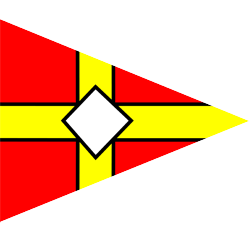Thanks to Ian Malcolm for the following guide.
You are aiming to set a course which will
- provide fair racing for all
- test the participants on all points of sail
- take around 45-60 minutes to complete.
Start off by following the suggestions below. You will only rarely be able to set a course which ticks all the boxes, so be prepared to make compromises. Once you have decided on a provisional course, you can always ask some of the more experienced racers if they agree with you.
Look for a start line at close to 90° to the wind and which gives a beat to the first mark. The clubhouse is a convenient place for the Race Officer to be for the start; there’s also a mobile flagpole, hooter, etc, which can be used at posts adjacent to M or L. The flagpole can also be fitted to the Dory to allow a committee boat start which can be angled to any wind; this can be useful when using L as a start with a need to get back to the starter box.
1. Try to avoid a downwind start or a start on a port tack.
Start lines worth considering include:
| Wind direction | Start line | First mark |
| North | M-X | L; K; D |
| East | Clubhouse-X | M |
| West; South-west | Clubhouse-X | A |
| West; North-west | Clubhouse-M | B; I |
| South; South-west | Shore-L* | M; Y; A |
*In benign conditions where safety boats are not likely to be required to attend capsizes, you can run this line from the starter’s box with a safety boat to check that no-one is over the line early.
2. Choose other marks so that you get a beat, a reach and a run. For class racing, remember that you can set different courses for different classes. If you use the same mark for more than one course, make sure that all boats round it in the same direction.
3. Aim for a course which will take the slowest boat around an hour to complete.
4. Decide on the number of laps. If in doubt, go for more laps than you think you’ll need: you can shorten a course during a race, you can’t lengthen it.
5. Try to ensure that there is a gybe mark. (Mark Y is designed to be moveable and can often be adjusted to give a gybe. Please do not move any other marks.)
6. Look for a finish line at 90° to the wind and which gives a beat from the last mark. If a beat finish is not possible, look for a line at 90° to the direction of the last mark: avoid a “hook” finish. If the finish line is Clubhouse-X, the previous mark should be A or M.
